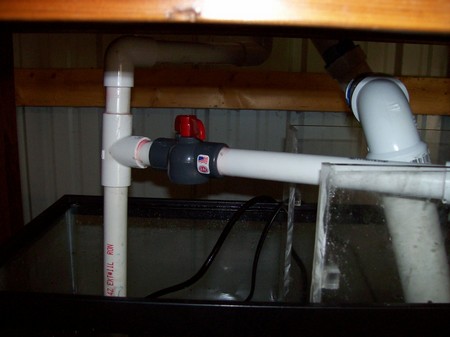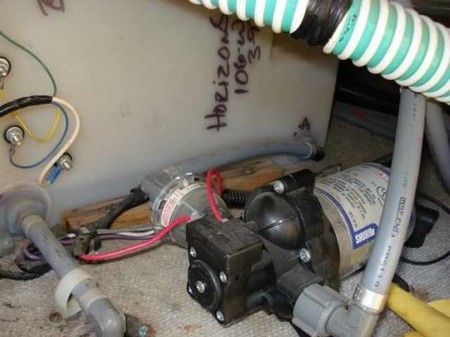Air locks are a common occurrence in heating systems and are fairly simple to cure. Air locks in the plumbing system, however, may be a little more complex to solve. There are two main possibilities when air locks occur in the hot water supply. Firstly, your plumber may have been an aspiring Picasso who decided to create a piece of modern art that could be nominated for the Turner Prize. Let me explain by pointing out that some plumbers (not particularly good ones), choose to take the easy option and go around objects rather than through them, hence creating a problem with too many bends! This can cause air pockets and resultant problems, which would take a skilled amateur or a professional to sort out.
The other more common cause is too great a demand on the reservoir (water tank) system in your home. You’re filling the bath for a lovely soak, running the hot and cold water taps at the same time.
This is a double demand on the water tank supply, as the cold tap is fed directly from the tank and the hot water cylinder is also fed from the tank. Somebody’s using the loo (that’s fed from the tank); the washing machine is switched on, fed from the cold mains slowing the supply to the tank. The hot feed to the washing machine is fed from the cylinder, also supplied from the tank. Now somebody’s doing the washing up, more demand on the mains cold supply which means even less water to the tank, and the hot supply is from the cylinder – even more demand from the tank! Get the picture?
Now, as if all that wasn’t enough, Grandad has decided to water the garden – even more demand on the mains – so practically nothing is left to feed the tank. The water level in the tank gets so low that it drops below the outlet pipe, thus allowing air into the system. These circumstances may seem exceptional, but in today’s society they are actually quite common – the demand for water is constantly growing!
When an airlock occurs, it normally appears as a spluttering and hissing tap. The air needs to be forced out, so to solve the problem, you’d best start at the first port of call (so to speak), the kitchen sink. Take a piece of rubber hose – slip one end over the spout of the kitchen mixer tap, and the other end over the spout of the bathroom basin hot tap. Turn the cold tap on the kitchen mixer tap wide open, then turn the hot tap on the basin wide open, which will force the air through the bathroom hot tap by using mains pressure until the water is flowing freely.
To clear the bath taps, repeat this process by closing the basin tap, and if necessary the tank supply, by closing the hand basin hot tap, forcing the air bubbles into the tank. The whole line is now clear.
If you have a mixer tap in the kitchen, remove the spout and hold your hand tightly over the opening. Fully open the hot tap and slowly open the cold and force the air up through the open bath tap.
Another common cause is if the water mains supply is turned off and the tank is emptied. This will allow air into the system. The remedial process is the same as described above.
Air trapped in a radiator is easily detected by touch. If only half the radiator is hot, you probably have an air pocket trapped within the radiator, which will affect its efficiency. There is a small bleed valve on the top left or right corner of the radiator. You will need a radiator key to open this valve (these are widely and cheaply available from plumber’s merchants or DIY stores). Push the radiator bleeding key onto the valveand turn it gently to release the trapped air (you will hear a hissing sound), until water begins to squirt out. When this happens, immediately shut off the bleed valve. Be prepared, and have some old rags on hand to soak up any spillage.
Check the water pressure indicator on your combi boiler. (Your boiler should display information on the panel regarding the level of pressure required.) If the pressure is low and needs topping up, carefully open up the screw on the valve in the filling loop at the bottom of the boiler, using a slotted screwdriver if necessary. Watch the water pressure indicator and shut off the feed immediately by turning back the valve screw when the correct pressure has been reached.
Categories
Advertisements
Recent Articles
 How to Understand Bed Sizes – A Small Guide
How to Understand Bed Sizes – A Small Guide How to Select Some Must Have Kitchen Accessories
How to Select Some Must Have Kitchen Accessories Best Way to Change a Car Tire
Best Way to Change a Car Tire Best Way to Write an Affirmation
Best Way to Write an Affirmation Best Way to Take Charge of Your Financial Life
Best Way to Take Charge of Your Financial Life Best Way to Survive a Party When You Don’t Know Anyone
Best Way to Survive a Party When You Don’t Know Anyone Best Way to Stop Self Sabotaging Yourself
Best Way to Stop Self Sabotaging Yourself Best Way to Start Journal Writing
Best Way to Start Journal Writing Best Way to Speak with a Powerful Voice
Best Way to Speak with a Powerful Voice Best Way to Simplify Your Life
Best Way to Simplify Your Life Best Way to Respond to a Put-Down
Best Way to Respond to a Put-Down Best Way to Reduce Acne Breakouts
Best Way to Reduce Acne Breakouts Best Way to Recover from Dining Disasters
Best Way to Recover from Dining Disasters Best Way to Quit Your Job Gracefully
Best Way to Quit Your Job Gracefully Best Way to Make Your Own Website
Best Way to Make Your Own Website



Leave a Reply